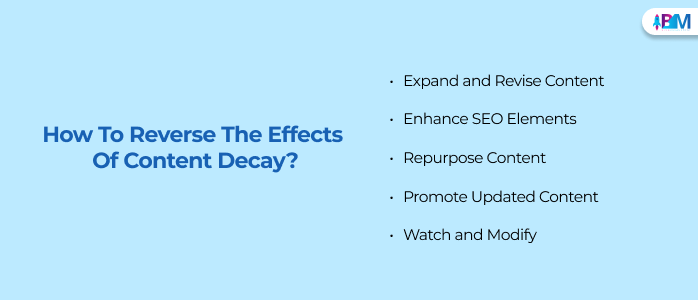Maintaining a website that regularly draws and engages visitors is a big task in the ever-changing digital world. Content decay is one of the less well-known but equally important problems influencing website performance.
Over time, this phenomenon might gradually weaken the efficacy of your content, lowering its search engine results and driving fewer visitors. This comprehensive guide will examine content decay, how to spot it, and practical methods for preventing and mitigating its impacts.
What Is Content Decay?

The term “content decay” describes how web content gradually loses relevance and efficacy over time.
This downturn can manifest as a drop in click-through rates, user engagement, or organic search ranks, among other things. Since search engine algorithms, consumer tastes, and new trends are constantly changing in the digital world, content decay is expected.
How To Identify Content Decay?
The first step in minimizing the consequences of content decay is recognizing it. The following are some crucial signs to watch out for:
- Reduced Organic Traffic: Monitor your website’s statistics to spot any noticeable declines in organic traffic. Content decay can occur if pages that were previously performing well begin to receive fewer visits.
- Diminished Search Engine Ranks: Use tools like Google Search Console to monitor your rankings. A large decline in a particular keyword’s ranking indicates that your content might not be as authoritative or relevant as it previously was.
- Reduced User Engagement: Monitor metrics like pages per session, average session length, and bounce rate. A drop in these measures can indicate that readers are less interested in or impressed by your content.
- Reduced Click-Through Rates (CTR): If your search engine listing experiences a decline in CTR, it can indicate that your meta descriptions and titles are no longer relevant or engaging.
- Reduced Backlinks: Monitor the quantity and quality of backlinks pointing to your content. A decline in backlinks could affect your content’s authority and rankings in search engines.
What Are The Causes Of Content Decay?
The first step to take towards mitigating the consequences of content decay is to understand what leads to it. Here are some common causes:
1. Outdated Information
Once-informative content can become out of date as industries and technology change. Outdated references, data, and procedures might make your content less credible.
Maintaining accuracy and relevancy requires regular updates and modifications to ensure your content meets user expectations and modern standards.
2. Algorithm Changes
Search engines often make algorithmic changes to enhance the credibility of search results. These modifications can impact the ranking of your article.
Adapting your content strategy to SEO best practices and algorithm upgrades can help you sustain or increase your presence in search results.
3. Increasing Competition
There is a steady stream of new content being released. Your content can be pushed down in search results by rivals’ more thorough, current, or better-optimized content.
You can stay competitive and maintain your rankings by routinely examining your rivals’ content and identifying areas for improvement.
4. Changes In User Intent
Users’ approaches to finding information might evolve over time. Terms and phrases that are used to drive traffic can no longer be relevant.
You can keep your content interesting and relevant by regularly conducting keyword research and monitoring changing user interests. This will help you adapt your content to current search behaviors.
How To Prevent Content Decay?
The pace of content decay can be considerably slowed by taking proactive steps. Here are some tips to maintain the relevancy and freshness of your content:
1. Frequent Content Audits
To find and update out-of-date or performing poorly, periodically conduct audits. To help with this process, use tools like Ahrefs, SEMrush, and Screaming Frog.
Frequent audits assist you in identifying opportunities and gaps so that your content continues to meet user expectations and current standards.
2. Update & Refresh Content
Update current content with the most recent data, figures, and fashions. Frequent changes can increase the authority and relevancy of your content.
Including current information and findings builds credibility and keeps readers interested and educated.
3. Adapt Your Content
Optimize your content for user intent to adapt it to their present intent. Use keyword research tools to find new trends and search patterns.
Regularly editing your content to better suit changing user queries can raise search rankings and guarantee your content’s continued usefulness and discoverability.
4. Boost Content Quality
Make your content more comprehensive and well-researched. Use case studies, new ideas, and images to increase your content’s value and engagement.
Comprehensive, high-quality content can set your website apart from the competition and boost user retention.
5. Create And Manage Backlinks
Always look for ways to obtain high-quality backlinks. Collaborating with others, producing shareable content, and guest blogging are some ways to do this.
High-quality backlinks increase the authority and exposure of your content, which also helps maintain search engine ranks and visitor development.
How To Reverse The Effects Of Content Decay?

If you find content that has already decayed, you can help it perform well again by doing the following actions:
1. Expand And Revise The Content
Update outdated content with fresh text, pictures, and videos. Expand on already-existing subjects to make the information more valuable and thorough.
Adding new, pertinent content on a regular basis will help improve engagement and draw in new backlinks, which will improve performance overall.
2. Enhance SEO Elements
Optimize your headers, internal links, title tags, and meta descriptions again. Target pertinent keywords and adhere to modern best practices.
This can greatly improve the visibility of your content in search results, resulting in an increase in organic traffic.
3. Repurpose Content
Convert previous blog entries into podcasts, infographics, or videos. Repurposing helps expand the audience for your content and give it fresh life.
With many touchpoints for audience involvement, this method optimizes the return on your current content investment.
4. Promote Updated Content
Email newsletters, social media, and other marketing platforms are used to spread the word about new content. Enhanced visibility can help recoup lost engagement and traffic.
Furthermore, consider utilizing influencers or collaborators to enhance your outreach and draw in a broader viewership.
5. Watch And Modify
Following an update, always monitor the new content’s performance. Analyse changes using analytics and adapt further as necessary.
Regular performance assessments can help you learn what works and what doesn’t, improving your plan for continued success.
Conclusion
Although content decay is an unavoidable part of maintaining a digital presence, it doesn’t have to be all bad.
Understanding the signs and causes of content decay and taking proactive and reactive measures can help you maintain your content’s relevance, freshness, and engagement.
Regular audits, timely changes, and clever SEO techniques are essential to ensure your content works effectively over time.
If you remain alert and adjust to developments, your content will remain an important component of your digital strategy.
Read More:
